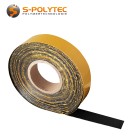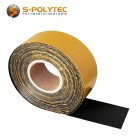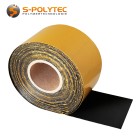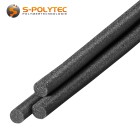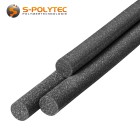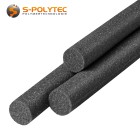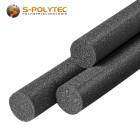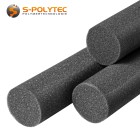
Sealing tapes & foam strips buy cheap online
We offer high-quality EPDM sealing tapes with self-adhesion and open-cell round cords made of polyurethane as filling material of silicone joints for long-lasting building sealing
- We offer high-quality foam strips made of PU for backfilling silicone joints
- We carry self-adhesive EPDM sealing tapes for sealing or as moisture barriers
- All our sealing tapes and foam strips are REACH & RoHS compliant in top quality
- Our sealing tapes and round cords are available at attractive graduated prices
EPDM sealing tape 36mm - 25m roll (self-adhesive)
 from €29.75 / pcs
from €29.75 / pcsIncl. 19% Tax
EPDM sealing tape 70mm - 25m roll (self-adhesive)
 from €47.60 / pcs
from €47.60 / pcsIncl. 19% Tax
EPDM sealing tape 110mm - 25m roll (self-adhesive)
 from €65.45 / pcs
from €65.45 / pcsIncl. 19% Tax
PU foam strip Ø 15mm (open cell)

PU foam strip Ø 20mm (open cell)
 from €0.24 / pcs
from €0.24 / pcsIncl. 19% Tax
PU foam strip Ø 25mm (open cell)
 from €0.39 / pcs
from €0.39 / pcsIncl. 19% Tax
PU foam strip Ø 30mm (open cell)

PU foam strip Ø 40mm (open cell)
 from €0.95 / pcs
from €0.95 / pcsIncl. 19% Tax
Sealing tapes & Round cords from the professional
EPDM sealing tapes for building waterproofing
EPDM sealing tapes are used for permanently elastic structural sealing. Whenever sealing with a silicone cannot be ensured due to the high width of the joint, an EPDM sealing tape can achieve the desired effect. In this context, the joint sealing tapes made of high-quality EPDM rubber offer several advantages. In contrast to silicone joints, sealing with an EPDM tape is considered to be maintenance-free, as its service life is more than 50 years when used properly. In addition, EPDM sealing tapes are enormously elastic and do not lose their very high elasticity even in the most adverse weather conditions or extreme temperature fluctuations. The processing of an EPDM sealing tape is also very simple, because it is simply applied by gluing it on. It does not need to be trowelled off with a joint smoother, nor do you have to pay attention to curing times.
We offer in our online store sealing tapes made of EPDM rubber in professional quality in various widths. These are each available in the thickness 0.8mm as a 25m roll at favourable graduated prices. Through the overlapping application, both the useful width and the useful length of the sealing tape can be increased. However, the overlap of the sealing tape should be at least 5mm. This is an advantage especially when sealing garage roofs or window profiles, when the required width of the sealing is too high, so that even the wide EPDM sealing tape with 110mm width is too small.
NOTE: Our EPDM sealing tapes are equipped with a self-adhesive backing and can be trimmed to the desired size with scissors or a sharp knife.
Application examples for EPDM sealing tapes
EPDM sealing tapes are used when sealing with silicone is not practical. Especially when sealing wooden substructures, EPDM sealing tape is an effective moisture barrier to protect the wooden beams and prevent rain or water logging from causing rot. The same applies to terrace roofing, whose supporting structure is built with wooden beams. Also in the case of fencing systems for the home garden, an EPDM sealing tape can protect the supporting wooden beams from moisture in the soil, so that they do not rot and have to be replaced prematurely. The small additional cost of a moisture barrier is insignificant compared to the maintenance costs to preserve the wooden structures.
However, sealing tapes made of EPDM rubber are not only suitable as a moisture barrier for wood, but are also ideal for sealing windows and doors. Even in the case of light wells of basement windows, a watertight and airtight seal can be achieved with the self-adhesive sealing tapes. Due to the fact that the service life of the permanently elastic EPDM is more than 50 years, they do not need to be renewed. Particularly if the wall connection joints of the window profiles are to be sealed later with a colour-matched silicone, the longevity of an EPDM is a significant advantage and contributes to sustainable building sealing, which has a particular effect on increasing energy efficiency. Even with basement windows, heavy rain or puddles formed on the masonry by rainwater can cause water to enter the basement. By simply sealing with an EPDM sealing tape, the risk is significantly reduced. The situation is similar with skylights. Here, too, an EPDM can significantly reduce drafts. This can also be done subsequently for roof windows that have already been installed.
Another common application for the versatile sealing tapes is the waterproofing of roofs on garages and modern properties with flat roofs. Although these are usually welded with special roofing membranes, the penetration of rainwater can be prevented, especially in the corners or at the weatherboards, if these are bonded with EDPM sealing tape. Even leaking welded joints of the roofing membranes can be sealed very easily and quickly with the self-adhesive sealing tape, without the need for a roofer to re-weld the surfaces. The biggest advantage of sealing roofs with EPDM sealing tapes is that, unlike roofing membranes made of bitumen, for example, they do not have to be welded by an open flame, which has a particular effect on the fire risk during installation.
- EPDM sealing tape protects wooden substructures in facade cladding
- An EPDM sealing tape provides an extremely durable moisture barrier
- Sealing with an EPDM sealing tape on window profiles prevents drafts
- EPDM sealing tapes are ideal for substructures in patio roofing and carports
- Depending on the width, wide expansion joints can also be sealed with the permanently elastic sealing tape
- EPDM sealing tapes are ideal for sealing skylights and light wells in basement windows
- and many more
NOTE: If EPDM sealing tapes are used as a moisture barrier, they should be applied with an overhang of at least 5mm.
Round cords for silicone joints
In our online store we carry a whole range of round cords made of open-cell polyethylene in meter lengths. Round cords are used to limit the depth of the joint in expansion joints or wall connection joints in order to avoid having to inject an unnecessary amount of silicone into the joint to achieve a tight joint. This not only reduces the consumption of sealant to a necessary level, but also helps to ensure that the elastic properties of the sealant are not impaired by excessive joint depth.
The processing of our round cords is very simple. Select a round cord whose diameter is larger than the joint to be filled and insert the round cord into the joint with slight pressure so that it lies completely in the joint. Make sure that the round cord is slightly lower than the edge of the joint so that the sealant can be applied in sufficient thickness. Also make sure that the round cord is not pressed in too deeply and that it has a tight fit. If sufficient hold to the sides is not ensured, a round cord with a larger diameter should be used.
In our store we offer open-cell round cords, of which the diameter can be very easily reduced by squeezing and thus adapted to the width of the joint. The advantage here is that even quite large diameters can be reduced to a very small dimension and used in very narrow joints without having to order different round cords. The flexible cords can also be laid around tight radii or corners.
- Round cords improve the effectiveness of elastic joint sealants with silicones
- Round cords can avoid excessive consumption of the sealant used
- Round cords ensure optimum two-flank adhesion for expansion and wall connection joints
- Our open-cell round cords are extremely flexible and very easy to process
- Round cords are suitable for all joint sealants and for interior and exterior joints
- Our round cords can be used for joints in damp rooms such as bathrooms, toilets or saunas
TIP: Shortening the round cords is very easy to do with scissors or a cutter knife.
Care and cleaning of sealing tapes & round cords
Generally, sealing tapes and round cords are completely covered by subsequent work steps so that they can no longer be reached. Therefore, cleaning is usually not necessary. Round cords are inserted into expansion joints and wall connection joints and usually sealed afterwards with a silicone, MS polymer or even an acrylic sealant. These joints can be cleaned after curing with ordinary water and a little household cleaner. Depending on the area of application, the EPDM sealing strips are also covered by a facade cladding, roof tiles or even plastic panels for patio roofing. However, the sealing can also be done in such a way that the black sealing tape remains visible. In this case, too, simple cleaning with a soapy water solution is possible without hesitation and without any loss of elastic properties. However, do not use a scouring pad at any time, as the rough, hard surface could damage the sealants and sealing tapes, so that the durability of the seal may be impaired.
Recycling of waterproofing material
Our round cords are made of polyethylene. This plastic can certainly be recycled, so that a disposal can take place via the yellow bag or the yellow garbage can. Due to the very low weight of the open-cell round cords, a sorted collection in lattice boxes is hardly worthwhile, so that the purchase by recycling companies usually promises only little success.
Our self-adhesive sealing tapes made of EPDM rubber are considered particularly sustainable due to their extremely long service life. As a rule, this exceeds the respective intended use. However, if residual EPDM sealing tape is left over, it can be easily recycled into shock-absorbing floor coverings for sports facilities or playgrounds, for example. Otherwise, thermal recycling to generate heating energy can also be considered as a disposal alternative. However, this by no means applies to the domestic fireplace, but to modern combined heat and power plants with appropriate filter systems.
